The marketing leadership landscape is undergoing a fundamental transformation. As companies grapple with economic uncertainty, budget constraints, and rapidly evolving customer expectations, the traditional model of full-time Chief Marketing Officers is being challenged by a more flexible alternative: fractional CMOs. Recent research from McKinsey reveals that companies with a single customer-oriented role in their executive committee see up to 2.3 times more growth than those with fragmented responsibilities [1]. Yet paradoxically, the number of CMOs at Fortune 500 companies has declined from 71% in 2023 to 66% in 2024 [2], while the fractional executive workforce has doubled from 60,000 to 120,000 professionals in just two years [3].
This comprehensive analysis examines the critical differences between fractional and traditional marketing leadership models, their respective benefits and limitations, and provides data-driven insights to help organizations make informed decisions about their marketing leadership structure. Drawing from authoritative sources, including McKinsey research, Gartner CMO surveys, and academic studies, we explore how these leadership models perform in today’s challenging business environment.
Why Marketing Leadership Matters More Than Ever in 2025
The marketing function has never faced greater complexity or higher stakes than it does today. According to Gartner’s 2024 CMO Survey, marketing budgets have dropped to just 7.7% of overall company revenue, representing a 15% decline from the previous year [4]. This budget compression occurs precisely when customer acquisition costs are rising, digital channels are becoming more saturated, and consumer behavior is increasingly unpredictable.
The fragmentation of marketing responsibilities across multiple C-suite roles has created what McKinsey researchers describe as a “choppy customer journey” [1]. The average Fortune 100 executive team has increased in size by 50% between 2020 and 2022, with new roles such as Chief Digital Officer, Chief Commercial Officer, and Chief Data Officer being added to address specific aspects of the customer experience [1]. However, this expansion has led to a critical problem: when everyone is responsible for the customer, no one truly owns the customer relationship.
Modern customers interact with brands across an average of 10 touchpoints during their buying journey, compared to just 5 touchpoints in 2016 [1]. More than 80% of consumers now use multiple channels for product research and purchase decisions [1]. This omnichannel reality demands coordinated leadership that can orchestrate consistent messaging and experiences across all customer interactions.
The stakes for effective marketing leadership have never been higher. Harvard Business Review research demonstrates that organizations with CMOs perform 15% better than those without dedicated marketing leadership [5]. Yet only 63% of Fortune 500 companies currently have CMOs in their executive structure [2], suggesting a significant gap between the need for marketing leadership and its actual implementation.
Economic uncertainty has intensified the pressure on marketing leaders to demonstrate clear return on investment. CFOs increasingly view marketing as a cost center rather than a growth investment, creating tension between short-term financial pressures and long-term brand building [1]. This environment has given rise to alternative leadership models, particularly fractional CMOs, who promise to deliver executive-level marketing expertise without the full-time commitment and associated costs.
The emergence of artificial intelligence and marketing technology has further complicated the leadership landscape. Gartner research indicates that 61% of CMOs increased their investment in marketing technology in 2023, with MarTech now consuming 17.3% of marketing budgets and projected to reach 30.9% within five years [6]. This technological complexity requires leaders who can navigate both strategic vision and technical implementation, a combination that traditional hiring models struggle to provide consistently.
Understanding the Fractional CMO Model
Definition and Core Characteristics
A fractional Chief Marketing Officer represents a paradigm shift in executive leadership, providing senior-level marketing expertise on a part-time, contract basis. Unlike traditional consultants who offer project-specific advice, fractional CMOs integrate deeply into an organization’s strategic planning and execution processes while maintaining the flexibility to serve multiple clients simultaneously.
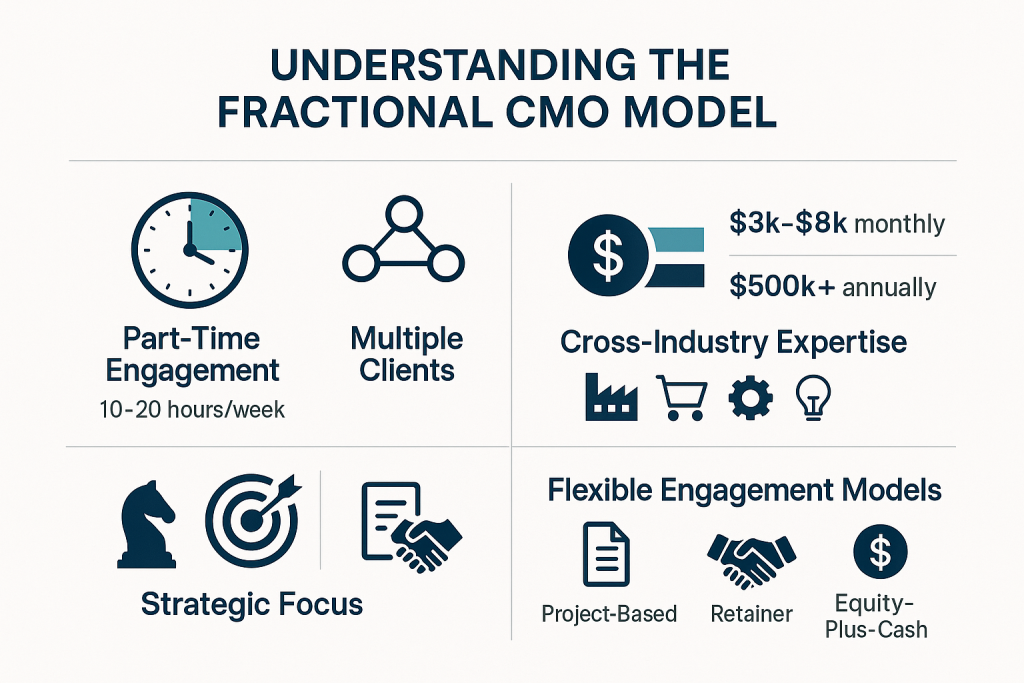
The fractional CMO model has experienced explosive growth, with the overall fractional executive workforce doubling from 60,000 professionals in 2022 to 120,000 in 2024 [3]. Industry analysts project that the global pool of fractional executives could exceed 500,000 professionals, with demand growing by nearly 20% year-over-year [7]. This growth reflects fundamental changes in how organizations approach executive leadership and resource allocation.
Operational Framework and Engagement Models
Fractional CMOs typically operate under three primary engagement models, each designed to address different organizational needs and budget constraints. The project-based model focuses on specific initiatives such as brand repositioning, product launches, or market entry strategies. Companies generating between $1 million and $50 million annually often utilize this approach, with fractional CMOs typically billing $3,000 to $8,000 per month for focused engagements [8].
The retainer model provides ongoing strategic guidance and oversight, with fractional CMOs dedicating 10-20 hours per week to an organization. This approach suits companies requiring consistent marketing leadership but lacking the budget or need for full-time executive presence. The equity-plus-cash model, increasingly popular among startups and growth-stage companies, combines reduced cash compensation with equity participation, aligning the fractional CMO’s interests with long-term company success.
Core Responsibilities and Value Proposition
Fractional CMOs assume responsibility for strategic marketing planning while maintaining focus on overall business priorities. Their role encompasses campaign management, team guidance, and professional development throughout marketing organizations. Unlike hands-on tactical roles, fractional CMOs primarily advise, mentor, and oversee deliverables while preparing internal teams to implement strategies efficiently.
The analytical component of fractional CMO work proves particularly valuable in today’s data-driven environment. These executives evaluate campaign outcomes and refine strategies based on performance data, bringing expertise that often stems from years of leading marketing teams across diverse industries. This cross-industry experience enables fractional CMOs to identify market trends and implement best practices that internal teams might not recognize.
Competitive Advantages and Market Positioning
The primary competitive advantage of fractional CMOs lies in their ability to provide immediate access to senior-level expertise without the lengthy recruitment and onboarding processes associated with full-time hires. Traditional CMO recruitment can take 6-12 months and cost upwards of $100,000 in search fees alone, while fractional CMOs can typically begin contributing within 2-4 weeks of engagement.
Fractional CMOs bring diverse industry experience that proves particularly valuable for companies entering new markets or facing unique challenges. Their exposure to multiple business models, customer segments, and competitive landscapes enables them to identify opportunities and threats that might escape internal teams. This breadth of experience becomes especially critical for companies operating in niche markets or emerging industries where traditional marketing approaches may prove inadequate.
Limitations and Potential Drawbacks
Despite their advantages, fractional CMOs face inherent limitations that organizations must carefully consider. The part-time nature of their engagement can limit their ability to build deep relationships with internal teams and fully understand complex organizational dynamics. Cultural integration, which proves critical for marketing effectiveness, may suffer when leadership presence is intermittent rather than constant.
Fractional CMOs may struggle with initiatives requiring intensive, hands-on management or those demanding immediate response to market changes. Their divided attention across multiple clients can create conflicts when urgent situations arise simultaneously across their portfolio. Additionally, the temporary nature of many fractional engagements may discourage long-term strategic thinking or investment in initiatives with extended payback periods.
The knowledge transfer challenge represents another significant limitation. When fractional CMO engagements conclude, organizations may find themselves without the institutional knowledge and strategic context that guided their marketing efforts. This brain drain can prove particularly problematic for companies that have not invested adequately in developing internal marketing capabilities during the fractional engagement period.
The Traditional CMO Approach
Organizational Integration and Leadership Presence
Traditional Chief Marketing Officers represent the established model of full-time, dedicated marketing leadership within organizations. These executives integrate completely into company culture, participating in all strategic decisions and maintaining constant presence during critical business moments. Their full-time commitment enables deep understanding of organizational dynamics, competitive positioning, and long-term strategic objectives.
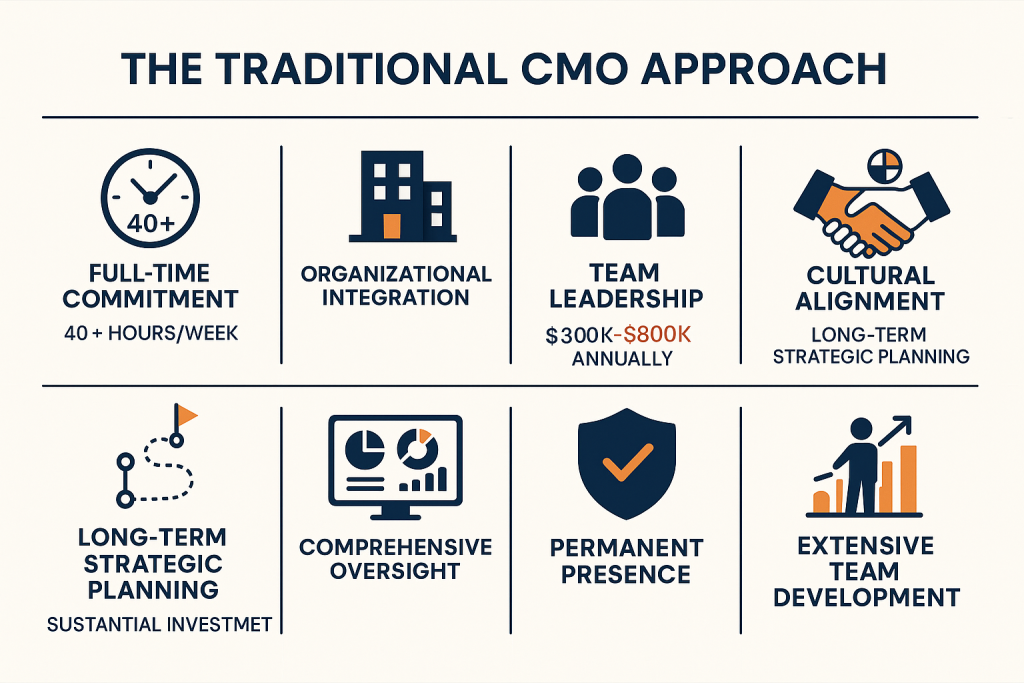
The traditional CMO model provides stability and continuity that proves particularly valuable for large organizations with complex marketing operations. These leaders oversee comprehensive teams, manage substantial budgets, and coordinate marketing efforts across multiple business units or geographic regions. Their permanent presence ensures consistent decision-making and enables the development of sophisticated, long-term marketing strategies.
Strategic Planning and Execution Capabilities
Traditional CMOs excel at creating detailed, long-term strategic plans that align marketing efforts with broader business objectives. Their full-time focus enables comprehensive market analysis, competitive intelligence gathering, and strategic planning that extends beyond immediate tactical needs. This strategic depth proves particularly valuable for companies operating in mature markets or those requiring complex, multi-year brand development initiatives.
The ability to manage large-scale marketing operations represents another key strength of traditional CMOs. These executives typically oversee teams of 20-100+ marketing professionals, coordinate budgets exceeding $10 million annually, and manage relationships with multiple agency partners and vendors. Their organizational leadership capabilities enable the execution of sophisticated marketing campaigns that require extensive coordination and resource management.
Cultural Leadership and Team Development
Traditional CMOs serve as cultural ambassadors for their organizations, embodying brand values and ensuring consistent messaging across all marketing touchpoints. Their permanent presence enables them to build strong relationships with internal stakeholders, from sales teams to product development groups, fostering collaboration that proves essential for effective marketing execution.
The team development aspect of traditional CMO leadership cannot be understated. These executives invest in building marketing capabilities within their organizations, developing talent pipelines and creating institutional knowledge that persists beyond their tenure. This investment in human capital development provides long-term value that extends far beyond immediate marketing outcomes.
Financial Investment and Resource Requirements
Traditional CMO compensation packages typically range from $300,000 to $800,000 annually for mid-market companies, with Fortune 500 organizations often exceeding $1 million when including bonuses and equity compensation [9]. These substantial investments reflect the comprehensive nature of traditional CMO responsibilities and the expectation of full-time dedication to organizational success.
Beyond direct compensation, traditional CMOs require significant supporting infrastructure, including administrative support, technology resources, and professional development investments. The total cost of traditional CMO leadership, including benefits, office space, and support staff, often exceeds $500,000 annually for mid-market organizations.
Performance Expectations and Accountability
Traditional CMOs face intense pressure to demonstrate measurable business impact across multiple dimensions simultaneously. They must balance brand-building activities with demand generation, manage both short-term revenue targets and long-term market positioning, and coordinate marketing efforts with sales, product, and customer success teams. This multifaceted accountability requires sophisticated measurement systems and clear performance metrics.
The permanence of traditional CMO roles creates both advantages and challenges in terms of accountability. While their long-term commitment enables sustained focus on strategic objectives, it also means they bear full responsibility for marketing performance during economic downturns or market disruptions. This accountability pressure has contributed to the historically high turnover rate among CMOs, with average tenure ranging from 18-24 months in many industries.
Challenges and Limitations
Traditional CMOs face several inherent challenges that have contributed to the rise of alternative leadership models. The rapid pace of marketing technology evolution often outpaces the learning capabilities of individual executives, creating knowledge gaps that can impact strategic decision-making. The average CMO must now understand dozens of marketing technology platforms, data analytics tools, and emerging channels while maintaining strategic focus on business objectives.
The isolation factor represents another significant challenge for traditional CMOs. Unlike fractional executives who benefit from exposure to multiple industries and business models, traditional CMOs may develop tunnel vision focused solely on their organization’s specific challenges. This limitation can reduce their ability to identify innovative solutions or recognize emerging market trends that affect their industry.
Budget constraints have intensified pressure on traditional CMOs to demonstrate immediate return on investment while building long-term brand value. The 15% decline in marketing budgets reported by Gartner creates a challenging environment where traditional CMOs must achieve more with fewer resources [4]. This pressure often forces short-term thinking that may compromise long-term strategic objectives.
Comparative Analysis: Performance and Outcomes
Effectiveness Metrics and Business Impact
Comparative analysis of fractional versus traditional CMO effectiveness reveals nuanced performance differences that vary significantly based on organizational context and specific business objectives. McKinsey research demonstrates that companies with single customer-oriented leadership roles achieve up to 2.3 times more growth than those with fragmented responsibilities [1], suggesting that leadership clarity matters more than the specific employment model.
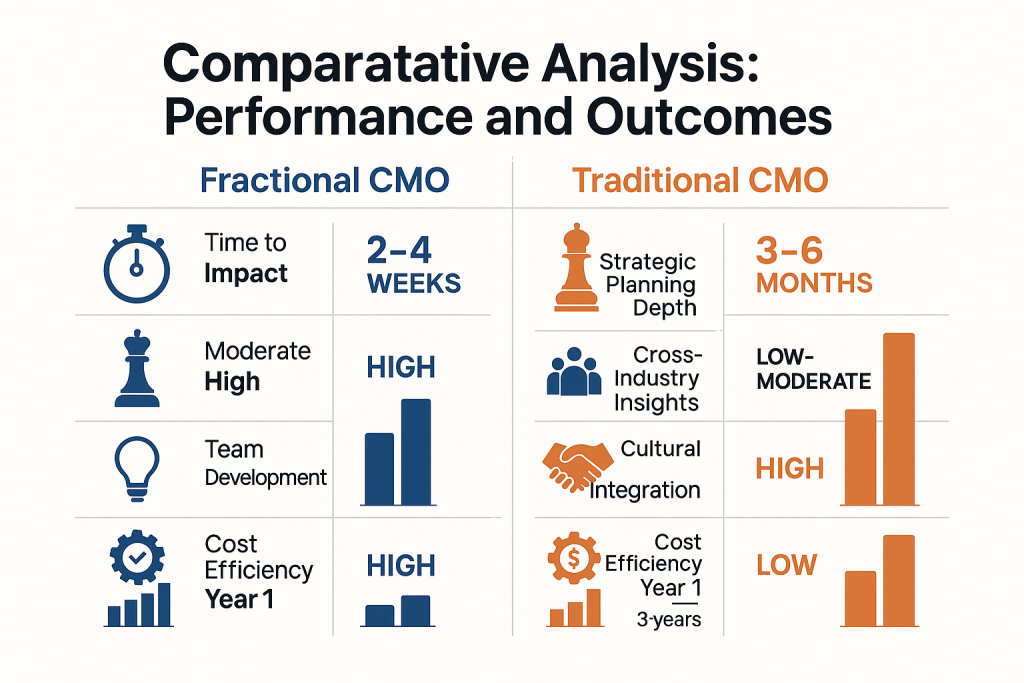
Harvard Business Review’s comprehensive study found that organizations with dedicated CMOs perform 15% better than those without marketing leadership [5]. However, this research did not distinguish between fractional and traditional CMO models, indicating that the presence of senior marketing leadership provides value regardless of employment structure. The key differentiator appears to be the quality and consistency of strategic marketing guidance rather than the full-time versus part-time nature of the role.
Time-to-Value and Implementation Speed
Fractional CMOs demonstrate significant advantages in time-to-value metrics, typically beginning meaningful contribution within 2-4 weeks of engagement compared to 3-6 months for traditional CMO onboarding. This speed advantage proves particularly valuable for companies facing immediate marketing challenges or those requiring rapid strategic pivots in response to market changes.
Traditional CMOs, while slower to initial impact, often demonstrate superior long-term value creation through sustained strategic development and team building. Their ability to invest time in understanding complex organizational dynamics and building comprehensive marketing capabilities typically yields greater returns over 18-24 month periods, particularly for large organizations with sophisticated marketing requirements.
| Performance Metric | Fractional CMO | Traditional CMO | Optimal Use Case |
|---|---|---|---|
| Time to Initial Impact | 2-4 weeks | 3-6 months | Fractional for urgent needs |
| Strategic Planning Depth | Moderate | High | Traditional for complex planning |
| Cross-Industry Insights | High | Low-Moderate | Fractional for innovation |
| Team Development | Limited | Extensive | Traditional for capability building |
| Cultural Integration | Moderate | High | Traditional for culture-critical roles |
| Cost Efficiency (Year 1) | High | Low | Fractional for budget constraints |
| Long-term Value (3+ years) | Moderate | High | Traditional for sustained growth |
Industry-Specific Performance Variations
Performance differences between fractional and traditional CMOs vary significantly across industries and company stages. Technology startups and growth-stage companies often benefit more from fractional CMO expertise due to their need for rapid scaling, diverse skill sets, and budget constraints. The fractional model’s flexibility aligns well with the dynamic nature of emerging technology markets and the need for specialized expertise in areas such as product marketing, growth hacking, and digital customer acquisition.
Established enterprises in traditional industries such as manufacturing, healthcare, and financial services typically achieve better results with traditional CMO leadership. These organizations require deep industry knowledge, complex stakeholder management, and long-term strategic planning that benefits from full-time executive attention. The regulatory requirements and risk management considerations in these industries often necessitate the comprehensive oversight that traditional CMOs provide.
Scalability and Growth Considerations
Fractional CMOs excel in environments requiring rapid scaling or market expansion, bringing proven methodologies and cross-industry best practices that accelerate growth initiatives. Their experience across multiple organizations enables them to identify scalable marketing systems and avoid common pitfalls that might delay growth. However, their part-time engagement may limit their ability to manage the operational complexity that accompanies rapid scaling.
Traditional CMOs demonstrate superior performance in managing sustained growth over extended periods, building marketing organizations that can support long-term expansion while maintaining brand consistency and operational efficiency. Their full-time focus enables the development of sophisticated marketing operations, talent pipelines, and strategic partnerships that support sustained competitive advantage.
Crisis Management and Adaptability
The COVID-19 pandemic and subsequent economic uncertainty provided a natural experiment in comparing fractional versus traditional CMO effectiveness during crisis periods. Fractional CMOs demonstrated superior adaptability, quickly implementing cost-effective digital marketing strategies and helping organizations pivot to new business models. Their exposure to multiple industries enabled them to identify successful crisis response strategies and adapt them across their client portfolio.
Traditional CMOs showed mixed performance during crisis periods, with some demonstrating exceptional leadership in guiding their organizations through uncertainty while others struggled with the rapid pace of change required. Those traditional CMOs who succeeded typically had strong analytical capabilities and were willing to abandon established strategies in favor of data-driven experimentation.
Financial Implications and ROI Considerations
Direct Cost Comparison and Budget Impact
The financial implications of fractional versus traditional CMO leadership extend far beyond simple salary comparisons, encompassing total cost of ownership, opportunity costs, and long-term value creation. Traditional CMO compensation packages for mid-market companies typically range from $300,000 to $800,000 annually, with total employment costs including benefits, equity, and support infrastructure often exceeding $500,000 per year [9].
Fractional CMO engagements present a dramatically different cost structure, with typical monthly retainers ranging from $3,000 to $15,000 depending on scope and seniority level [8]. Annual fractional CMO costs rarely exceed $180,000, representing potential savings of 60-70% compared to traditional full-time leadership. However, this cost comparison must be evaluated against the scope of services provided and the depth of organizational integration achieved.
The budget impact extends beyond direct compensation to include recruitment costs, which can reach $100,000-$200,000 for traditional CMO searches when including executive search fees, interview expenses, and onboarding costs. Fractional CMO engagements typically begin with minimal upfront costs, providing immediate budget relief for organizations facing financial constraints.
Return on Investment Analysis
ROI analysis for marketing leadership investments requires careful consideration of both quantitative metrics and qualitative benefits that may not appear immediately in financial statements. Organizations utilizing fractional CMOs often report faster time-to-positive ROI due to lower initial investment and quicker implementation of revenue-generating initiatives. The typical fractional CMO engagement achieves positive ROI within 3-6 months, compared to 12-18 months for traditional CMO hires.
However, long-term ROI calculations favor traditional CMO leadership in many scenarios, particularly for organizations with substantial marketing budgets and complex operational requirements. Traditional CMOs’ ability to build comprehensive marketing capabilities, develop internal talent, and create sustainable competitive advantages often generates superior returns over 3-5 year periods despite higher initial investment.
| Cost Factor | Fractional CMO (Annual) | Traditional CMO (Annual) | Savings/Premium |
|---|---|---|---|
| Base Compensation | $36,000 – $180,000 | $300,000 – $800,000 | 60-70% savings |
| Benefits & Equity | $0 | $75,000 – $200,000 | 100% savings |
| Recruitment Costs | $0 – $5,000 | $50,000 – $150,000 | 90-95% savings |
| Support Infrastructure | $0 – $10,000 | $25,000 – $75,000 | 70-85% savings |
| Total Annual Cost | $40,000 – $200,000 | $450,000 – $1,200,000 | 65-75% savings |
Budget Allocation and Resource Optimization
The cost savings achieved through fractional CMO leadership enable organizations to reallocate budget toward direct marketing activities rather than overhead expenses. Companies utilizing fractional CMOs often report 20-30% increases in marketing program spending due to reduced leadership costs, potentially generating greater market impact through enhanced campaign investment.
This budget reallocation proves particularly valuable in today’s environment, where Gartner research shows marketing budgets have declined to 7.7% of company revenue [4]. Organizations facing budget pressure can maintain senior-level marketing guidance while preserving resources for customer acquisition and brand-building activities that directly impact revenue generation.
Risk Assessment and Financial Exposure
Fractional CMO engagements present lower financial risk due to their flexible, contract-based nature. Organizations can terminate or modify fractional arrangements with minimal financial penalty, providing protection against poor performance or changing business needs. This flexibility proves particularly valuable during economic uncertainty when companies must rapidly adjust expenses to match revenue fluctuations.
Traditional CMO employment creates significant financial exposure through severance obligations, equity vesting, and the substantial costs associated with executive turnover. The average CMO tenure of 18-24 months means organizations frequently face recruitment and onboarding costs multiple times within a five-year period, substantially increasing the total cost of traditional marketing leadership.
Opportunity Cost Considerations
The opportunity cost analysis reveals complex trade-offs between immediate cost savings and long-term capability development. Organizations choosing fractional CMO leadership may sacrifice the deep organizational knowledge and sustained strategic development that traditional CMOs provide. This trade-off becomes particularly significant for companies requiring sophisticated marketing operations or those operating in highly regulated industries.
Conversely, organizations investing in traditional CMO leadership may miss opportunities for rapid market expansion or innovative marketing approaches that fractional CMOs’ cross-industry experience could provide. The opportunity cost of traditional CMO investment includes the potential for alternative uses of the substantial financial resources required for full-time executive leadership.
Scalability and Growth Investment
The scalability implications of each leadership model create different financial dynamics as organizations grow. Fractional CMO costs typically scale linearly with engagement scope, allowing organizations to increase marketing leadership investment gradually as revenue grows. This scalability aligns well with startup and growth-stage company cash flow patterns.
Traditional CMO investment represents a significant fixed cost that may exceed optimal levels for smaller organizations but becomes increasingly cost-effective as marketing budgets and team sizes grow. The break-even point typically occurs when annual marketing budgets exceed $5-10 million, at which point traditional CMO leadership often provides superior value despite higher absolute costs.
Implementation Challenges and Limitations
Fractional CMO Implementation Challenges
The implementation of fractional CMO leadership presents several significant challenges that organizations must carefully navigate to achieve success. The most critical challenge involves establishing clear communication protocols and decision-making authority when the marketing leader maintains only a part-time presence. Organizations often struggle with the ambiguity surrounding when fractional CMOs should be consulted on urgent decisions versus when internal teams should proceed independently.
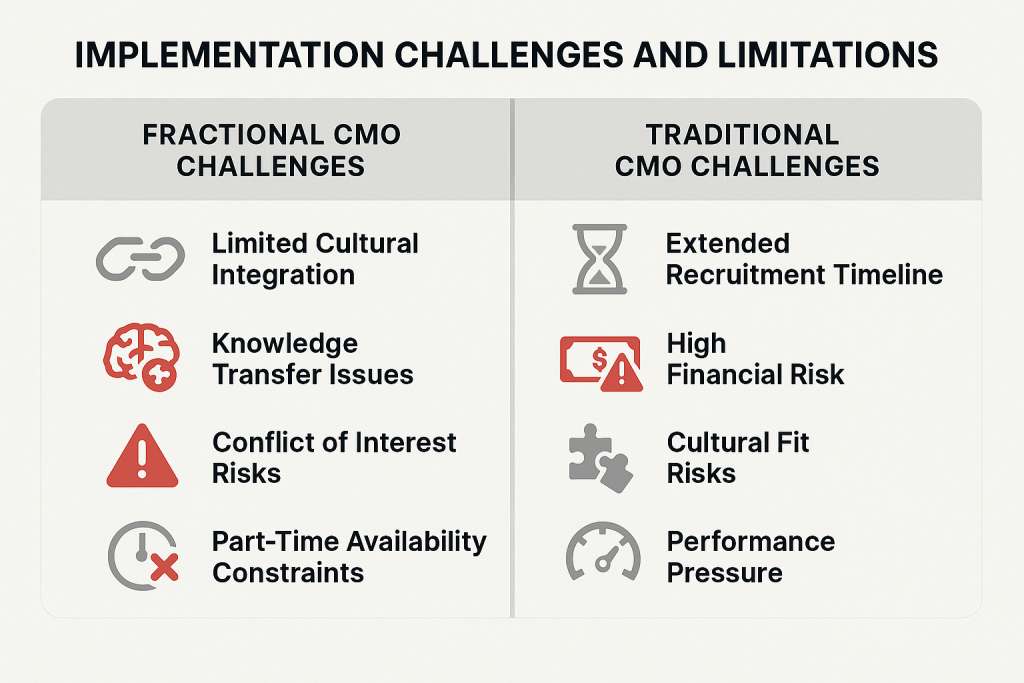
Cultural integration represents another substantial challenge for fractional CMO implementations. Unlike traditional executives who participate in daily organizational life, fractional CMOs must build relationships and establish credibility within compressed timeframes. This limitation can impede their ability to influence cross-functional collaboration, particularly with sales, product, and customer success teams, where marketing alignment proves critical for business success.
The knowledge transfer challenge becomes particularly acute when fractional CMO engagements conclude. Organizations may find themselves without the strategic context and institutional knowledge that guided their marketing efforts, creating potential disruption in marketing effectiveness. This risk intensifies when companies fail to invest adequately in developing internal marketing capabilities during the fractional engagement period.
Conflict of interest concerns arise when fractional CMOs serve multiple clients simultaneously, particularly within similar industries or geographic markets. While most fractional executives maintain strict confidentiality protocols, the potential for competitive intelligence sharing or divided attention during critical periods creates legitimate organizational concerns that must be addressed through careful contract structuring and ongoing monitoring.
Traditional CMO Implementation Challenges
Traditional CMO implementation faces its own set of substantial challenges, beginning with the extended recruitment and onboarding timeline that can leave organizations without senior marketing leadership for 6-12 months. This gap often occurs during critical business periods when marketing guidance proves most valuable, potentially resulting in missed opportunities or strategic missteps.
The cultural fit challenge represents a significant risk in traditional CMO hiring, as executive-level misalignment can create organizational disruption that extends far beyond the marketing function. The high-stakes nature of traditional CMO roles means that poor hiring decisions carry substantial financial and operational consequences, including severance costs, team disruption, and the need to restart the recruitment process.
Traditional CMOs often struggle with the rapid pace of marketing technology evolution, particularly when their experience centers on traditional marketing channels or established industry practices. The average CMO must now understand dozens of marketing technology platforms while maintaining strategic focus, creating a learning curve that can impede immediate effectiveness and strategic decision-making.
Budget pressure and performance expectations create additional implementation challenges for traditional CMOs. With marketing budgets declining by 15% according to Gartner research [4], traditional CMOs face intense pressure to demonstrate immediate ROI while building long-term brand value. This pressure often forces short-term thinking that may compromise strategic objectives and sustainable growth initiatives.
Organizational Readiness and Capability Gaps
Successful implementation of either leadership model requires careful assessment of organizational readiness and existing marketing capabilities. Organizations with limited internal marketing expertise may struggle to maximize value from fractional CMO engagements, as these leaders typically focus on strategic guidance rather than tactical execution. The absence of capable internal teams can limit fractional CMO effectiveness and reduce overall return on investment.
Conversely, organizations with sophisticated marketing operations may find traditional CMO leadership redundant if existing teams already possess strong strategic and execution capabilities. The substantial investment in traditional CMO leadership may not generate proportional returns when internal capabilities already meet organizational needs effectively.
Technology infrastructure and data analytics capabilities represent critical readiness factors for both leadership models. Modern marketing leadership requires sophisticated measurement systems, customer data platforms, and marketing automation tools. Organizations lacking these foundational elements may struggle to support either fractional or traditional CMO effectiveness, regardless of the leader’s individual capabilities.
Performance Measurement and Accountability Challenges
Establishing appropriate performance metrics and accountability structures presents unique challenges for each leadership model. Fractional CMO performance measurement must account for their limited time investment and shared attention across multiple clients. Traditional metrics such as team development, cultural leadership, and long-term strategic planning may not apply appropriately to fractional engagements.
Traditional CMO accountability faces different challenges, particularly in balancing short-term performance expectations with long-term strategic objectives. The pressure for immediate results can conflict with the time required for comprehensive strategy development and implementation, creating tension between quarterly performance reviews and strategic marketing timelines.
The attribution challenge affects both models but manifests differently based on engagement structure. Fractional CMOs may struggle to demonstrate clear attribution for business results when their involvement represents only one component of broader marketing efforts. Traditional CMOs face attribution challenges when marketing results depend on factors beyond their direct control, such as product quality, pricing strategies, or competitive dynamics.
Succession Planning and Continuity Risks
Succession planning presents distinct challenges for each leadership model that organizations must address proactively. Fractional CMO engagements typically include defined end dates or termination clauses that can create strategic discontinuity if succession planning receives inadequate attention. Organizations must develop internal capabilities or identify replacement fractional leaders well in advance of engagement conclusions.
Traditional CMO succession planning faces different challenges related to the high turnover rates characteristic of the role. With average CMO tenure ranging from 18-24 months, organizations must maintain continuous succession planning processes while supporting current leadership effectiveness. The substantial investment in traditional CMO leadership makes turnover particularly costly and disruptive.
Knowledge management and institutional memory preservation require different approaches for each model. Fractional CMO engagements must include explicit knowledge transfer protocols and documentation requirements to ensure strategic continuity. Traditional CMO departures often result in significant knowledge loss despite longer tenure, particularly when succession planning receives inadequate attention or internal development proves insufficient.
Visual Framework and Data Analysis
The following visual analysis provides comprehensive insights into the fractional versus traditional CMO landscape, drawing from authoritative research and market data to illustrate key trends and decision factors.
Comparative Analysis Overview
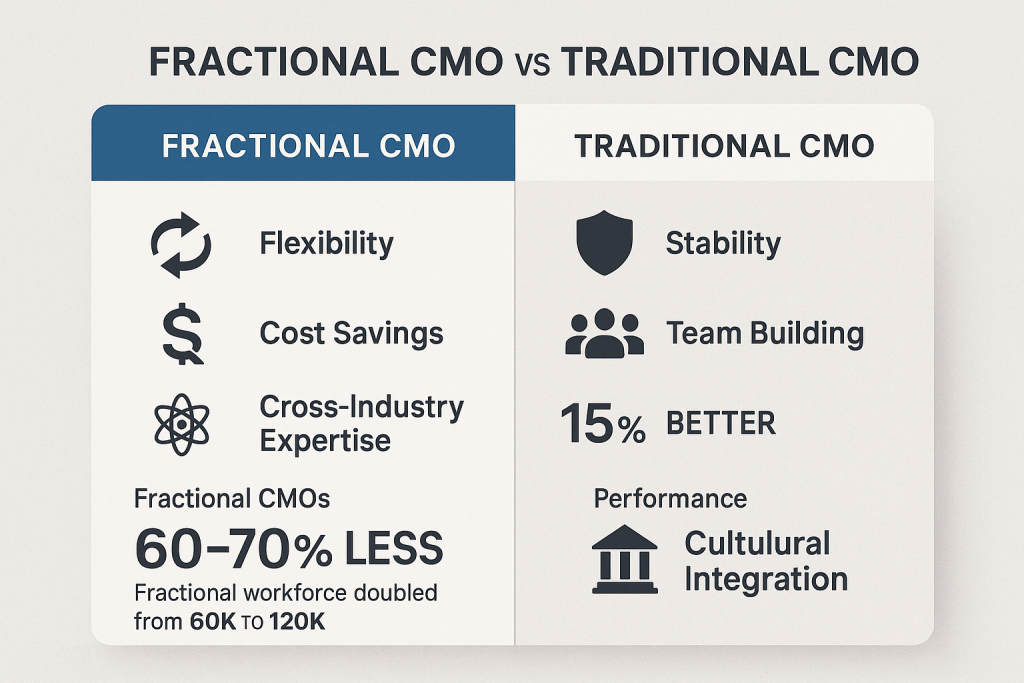
This comprehensive comparison illustrates the fundamental differences between fractional and traditional CMO models. The data clearly demonstrates that fractional CMOs provide significant cost advantages, typically costing 60-70% less than traditional full-time executives, while traditional CMOs deliver superior performance in organizational integration and long-term strategic development.
Market Budget Trends and Implications
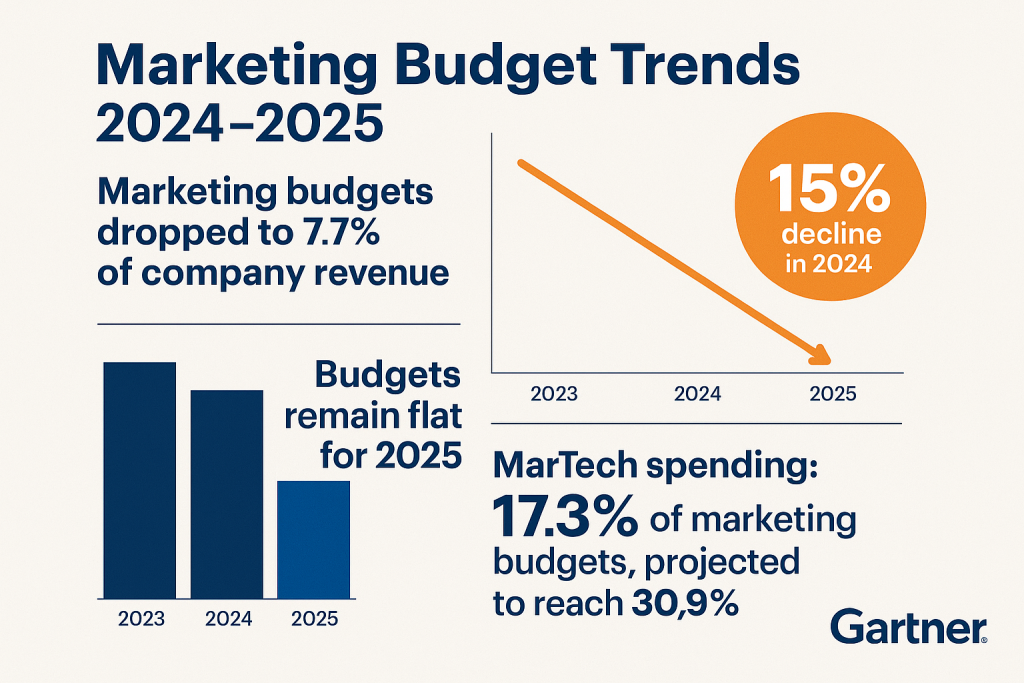
The Gartner research data reveals a challenging environment for marketing leadership, with budgets declining significantly while technology investments continue to grow. This trend directly impacts the viability of different leadership models, as organizations seek to maintain strategic marketing guidance while reducing overhead costs. The 15% budget decline creates pressure that favors more cost-effective leadership approaches, contributing to the growth in fractional executive adoption.
Fractional Executive Market Growth
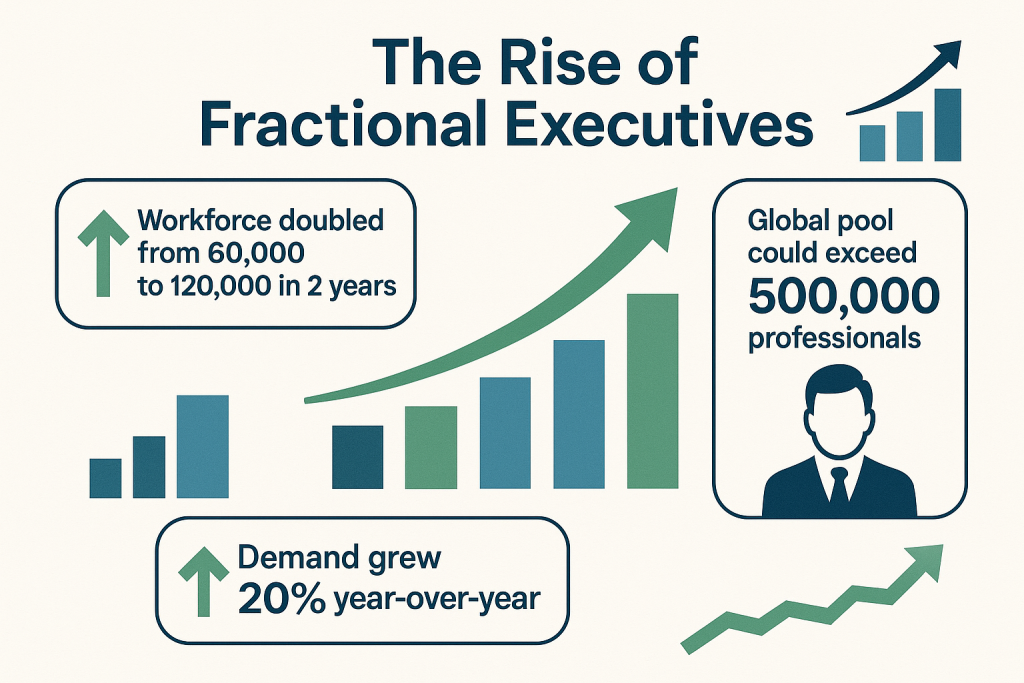
The exponential growth in fractional executive adoption reflects fundamental changes in how organizations approach leadership and resource allocation. The doubling of the fractional workforce in just two years indicates strong market validation of this model, while the projected growth to over 500,000 professionals suggests this trend will continue accelerating.
Strategic Decision Framework
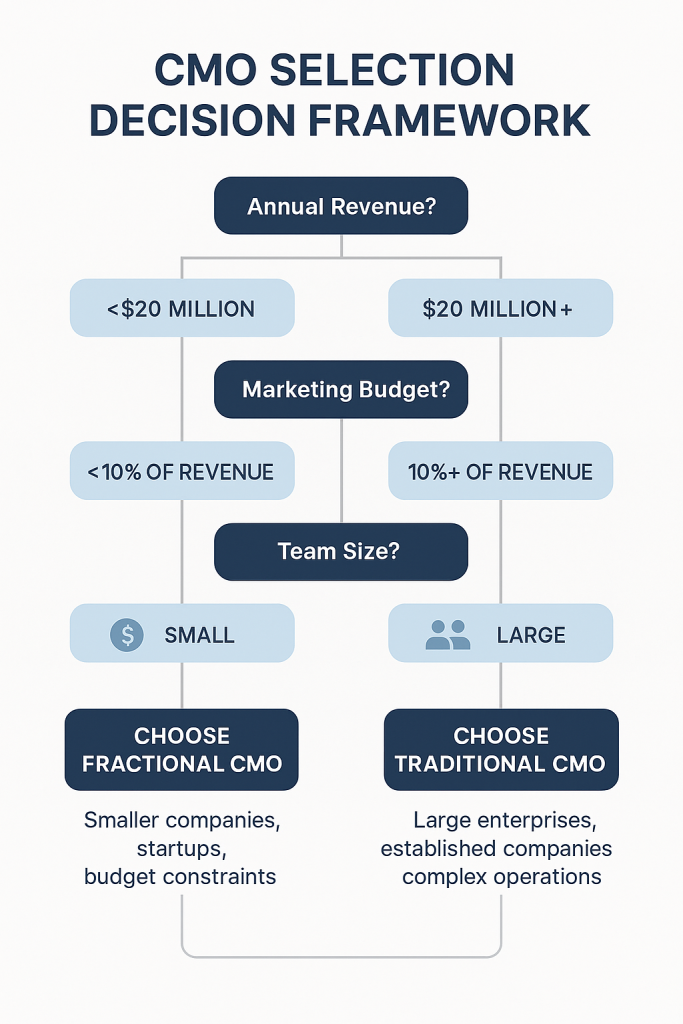
This decision framework provides a systematic approach for organizations to evaluate which leadership model best fits their specific circumstances. The framework considers multiple factors, including revenue size, marketing budget allocation, team structure, and growth stage, to guide strategic decision-making.
Modern Marketing Leadership Environment

The modern marketing leadership environment requires sophisticated analytical capabilities, cross-functional collaboration, and data-driven decision making. Both fractional and traditional CMO models must navigate this complex landscape while delivering measurable business results in an increasingly competitive marketplace.
Strategic Implementation Guide
Assessment and Planning Phase
Organizations considering either fractional or traditional CMO leadership must begin with a comprehensive assessment of their current marketing capabilities, strategic objectives, and resource constraints. This evaluation process should examine existing team competencies, technology infrastructure, budget allocation, and competitive positioning to establish baseline requirements for marketing leadership.
The assessment phase should include detailed analysis of marketing performance metrics, customer acquisition costs, lifetime value calculations, and attribution modeling capabilities. Organizations lacking sophisticated measurement systems may require additional investment in analytics infrastructure regardless of their chosen leadership model. This foundational work proves essential for either fractional or traditional CMO success.
| Assessment Area | Key Questions | Success Criteria |
|---|---|---|
| Current Marketing Capabilities | What skills exist internally? What gaps need addressing? | Clear capability map with identified strengths and weaknesses |
| Budget and Resources | What is the total marketing budget? How is it currently allocated? | Detailed budget analysis with ROI metrics by channel |
| Strategic Objectives | What are the 12-24 month marketing goals? How do they align with business objectives? | Specific, measurable marketing objectives tied to business outcomes |
| Technology Infrastructure | What marketing technology exists? What additional tools are needed? | Technology audit with integration and capability assessment |
| Competitive Position | How does current marketing performance compare to competitors? | Competitive analysis with market share and positioning insights |
Fractional CMO Implementation Strategy
Organizations choosing fractional CMO leadership should establish clear engagement parameters, communication protocols, and success metrics before beginning the relationship. The implementation process requires careful attention to integration challenges and knowledge transfer mechanisms to maximize value from the part-time engagement model.
Successful fractional CMO implementations typically begin with intensive strategic planning sessions to establish marketing direction, followed by regular check-ins and milestone reviews. Organizations should designate internal marketing leaders to serve as primary contacts and ensure continuity between fractional CMO sessions. This approach helps bridge the gap created by part-time presence while maintaining strategic momentum.
The onboarding process for fractional CMOs should include comprehensive briefings on company culture, competitive landscape, customer segments, and existing marketing initiatives. While fractional CMOs bring external expertise, they require sufficient context to make informed strategic decisions. Organizations should prepare detailed briefing materials and schedule intensive orientation sessions to accelerate the fractional CMO’s understanding of business dynamics.
Traditional CMO Implementation Strategy
Traditional CMO implementation requires comprehensive recruitment planning, cultural integration processes, and long-term strategic development frameworks. The extended timeline for traditional CMO hiring necessitates careful interim leadership arrangements and strategic continuity planning to avoid marketing disruption during transition periods.
The recruitment process should emphasize cultural fit alongside technical competencies, as traditional CMOs must integrate deeply into organizational dynamics. Organizations should involve multiple stakeholders in the interview process, including sales leadership, product management, and customer success teams, to ensure cross-functional alignment. The substantial investment in traditional CMO leadership justifies extensive due diligence and reference checking.
Onboarding for traditional CMOs should extend over 90-120 days and include a comprehensive immersion in all aspects of the business. This process should encompass customer interviews, competitive analysis, team assessments, and strategic planning sessions. The goal is to enable traditional CMOs to develop deep organizational knowledge that supports long-term strategic effectiveness.
Performance Monitoring and Optimization
Both leadership models require sophisticated performance monitoring systems that track leading and lagging indicators of marketing effectiveness. Organizations should establish baseline metrics before leadership transitions and implement regular review processes to assess progress against strategic objectives.
Key performance indicators should include both quantitative metrics, such as customer acquisition cost, lifetime value, and revenue attribution, as well as qualitative measures, such as brand perception, team satisfaction, and strategic alignment. The measurement framework should account for the different time horizons and engagement models associated with fractional versus traditional CMO leadership.
Regular performance reviews should examine not only marketing outcomes but also the effectiveness of the chosen leadership model itself. Organizations should be prepared to adjust engagement parameters, modify success criteria, or even transition between leadership models based on evolving business needs and performance results.
Risk Mitigation and Contingency Planning
Effective implementation requires comprehensive risk assessment and mitigation strategies for both leadership models. Fractional CMO engagements should include contingency plans for conflicts of interest, availability issues, and knowledge transfer challenges. Organizations should maintain relationships with multiple fractional executives to ensure continuity if primary relationships encounter difficulties.
Traditional CMO implementations should address succession planning, performance management, and cultural integration risks. The substantial investment in traditional leadership makes these risk mitigation efforts particularly important for organizational stability and strategic continuity.
Future Trends and Market Evolution
Technology-Driven Transformation
The marketing leadership landscape will continue evolving rapidly as artificial intelligence, machine learning, and marketing automation technologies reshape strategic requirements. Gartner’s projection that MarTech spending will reach 30.9% of marketing budgets within five years [6] indicates that future marketing leaders must possess sophisticated technical competencies alongside traditional strategic skills.
This technological evolution favors fractional CMO models in several ways. The rapid pace of technology change makes it difficult for individual executives to maintain expertise across all relevant platforms and methodologies. Fractional CMOs’ exposure to multiple organizations and technology stacks provides them with broader technical knowledge that proves increasingly valuable as marketing becomes more complex and technology-dependent.
However, the integration challenges associated with advanced marketing technology may also favor traditional CMO leadership in larger organizations. The implementation of sophisticated marketing automation, customer data platforms, and artificial intelligence tools requires sustained attention and deep organizational knowledge that part-time executives may struggle to provide effectively.
Economic Pressures and Budget Optimization
The continued pressure on marketing budgets, evidenced by the 15% decline reported by Gartner [4], will likely accelerate the adoption of cost-effective leadership models. Organizations facing budget constraints will increasingly view fractional CMO leadership as a viable alternative to traditional executive structures, particularly for companies with annual revenues below $50 million.
This trend may create a bifurcated market where smaller organizations increasingly rely on fractional leadership while larger enterprises maintain traditional CMO structures. The break-even point for traditional CMO investment will likely shift upward as cost pressures intensify, potentially expanding the addressable market for fractional executives.
Economic uncertainty will also drive demand for flexible leadership arrangements that can scale with business performance. Fractional CMO models provide this flexibility, allowing organizations to adjust marketing leadership investment based on revenue fluctuations and market conditions. This adaptability becomes particularly valuable during economic downturns or periods of rapid growth.
Evolving Customer Expectations and Channel Complexity
The continued expansion of customer touchpoints and channel complexity will increase the strategic demands on marketing leadership regardless of the employment model. McKinsey’s research showing that B2B buyers now use 10 interaction points compared to 5 in 2016 [1] suggests this trend will continue accelerating, requiring marketing leaders to orchestrate increasingly sophisticated customer journeys.
This complexity may favor traditional CMO leadership for organizations with substantial customer bases and complex sales processes. The coordination required to manage omnichannel customer experiences often benefits from full-time executive attention and deep organizational integration. However, fractional CMOs’ cross-industry experience may provide valuable insights into emerging channel strategies and customer engagement approaches.
Regulatory and Compliance Considerations
Increasing regulatory scrutiny of data privacy, advertising practices, and customer communications will create additional complexity for marketing leadership. Regulations such as GDPR, CCPA, and emerging AI governance frameworks require sustained attention and deep compliance knowledge that may favor traditional CMO models in regulated industries.
Organizations in healthcare, financial services, and other heavily regulated sectors may find that compliance requirements necessitate full-time marketing leadership with deep regulatory expertise. The risk associated with compliance failures often justifies the additional investment in traditional CMO leadership despite budget pressures.
Talent Market Dynamics
The marketing talent market will likely continue fragmenting as professionals seek greater flexibility and work-life balance. The growth in fractional executive supply, from 60,000 to 120,000 professionals in two years [3], reflects broader workforce trends toward independent contracting and flexible employment arrangements.
This talent market evolution may improve the quality and availability of fractional CMO candidates while potentially reducing the pool of executives willing to accept traditional full-time roles. Organizations may find themselves competing more intensively for traditional CMO talent while having access to a broader range of fractional alternatives.
The emergence of specialized fractional CMO platforms and marketplaces will likely improve matching between organizations and fractional executives, reducing search costs and improving engagement quality. These platforms may also provide standardized performance metrics and engagement frameworks that address some of the current challenges in fractional CMO management.
Industry-Specific Evolution
Different industries will likely evolve at different rates in their adoption of alternative marketing leadership models. Technology companies, startups, and professional services firms will probably continue leading fractional CMO adoption due to their comfort with flexible employment arrangements and project-based work.
Traditional industries such as manufacturing, healthcare, and financial services may maintain a preference for traditional CMO leadership due to regulatory requirements, complex stakeholder relationships, and conservative organizational cultures. However, budget pressures and competitive dynamics may gradually drive these industries toward more flexible leadership models.
The emergence of industry-specific fractional CMO specializations will likely improve the effectiveness of part-time leadership in complex sectors. Fractional CMOs with deep expertise in specific industries can provide the specialized knowledge that traditional generalist approaches might lack while maintaining the cost and flexibility advantages of the fractional model.
Key Takeaways
- Leadership model choice significantly impacts business outcomes: McKinsey research demonstrates that companies with single customer-oriented leadership roles achieve up to 2.3 times more growth than those with fragmented responsibilities, emphasizing the importance of clear marketing leadership regardless of employment model [1].
- Cost efficiency favors fractional CMOs for smaller organizations: Fractional CMO engagements typically cost 60-70% less than traditional full-time executives, with annual costs ranging from $40,000-$200,000 compared to $450,000-$1,200,000 for traditional CMO leadership including benefits and infrastructure [8][9].
- Market trends support fractional executive growth: The fractional executive workforce has doubled from 60,000 to 120,000 professionals in just two years, with demand growing 20% year-over-year and global projections exceeding 500,000 professionals [3][7].
- Budget pressures create opportunities for alternative models: Gartner research shows marketing budgets have declined 15% to just 7.7% of company revenue, creating pressure for cost-effective leadership solutions while maintaining strategic marketing guidance [4].
- Implementation success requires careful planning: Both fractional and traditional CMO models require sophisticated assessment, clear performance metrics, and appropriate organizational support to achieve optimal results, with success depending more on implementation quality than employment model choice.
Frequently Asked Questions
What is the typical engagement duration for fractional CMOs
Fractional CMO engagements typically range from 6-18 months for project-based work, with ongoing retainer relationships often extending 2-3 years. The duration depends on organizational needs, project scope, and strategic objectives. Some companies maintain long-term fractional relationships that evolve as business needs change.
How do fractional CMOs handle confidentiality across multiple clients?
Professional fractional CMOs maintain strict confidentiality protocols and typically avoid serving direct competitors simultaneously. Most establish clear conflict-of-interest policies and use non-disclosure agreements to protect client information. Industry best practices include geographic or sector-based client separation to minimize potential conflicts.
What are the minimum qualifications for effective fractional CMO candidates?
Effective fractional CMOs typically possess 10+ years of senior marketing experience, demonstrated success across multiple industries, strong analytical and strategic planning capabilities, and excellent communication skills. Many hold advanced degrees and professional certifications, with proven track records of driving measurable business results in diverse organizational contexts.
How do organizations measure ROI for fractional versus traditional CMO investments?
ROI measurement should include both direct costs (compensation, benefits, infrastructure) and indirect factors (time-to-value, strategic impact, team development). Fractional CMOs often show faster initial ROI due to lower costs and quicker implementation, while traditional CMOs may demonstrate superior long-term value through sustained capability building and organizational development.
Can fractional CMOs effectively manage large marketing teams?
Fractional CMOs can provide strategic guidance and oversight for large teams but may struggle with day-to-day management responsibilities. Success typically requires strong internal marketing managers to handle operational details while the fractional CMO focuses on strategy, planning, and high-level decision making. Team size and complexity are important factors in determining fractional CMO viability.
What industries benefit most from fractional CMO leadership?
Technology companies, professional services, startups, and growth-stage businesses typically benefit most from fractional CMO leadership due to their need for specialized expertise, budget constraints, and comfort with flexible employment arrangements. Traditional industries with complex regulatory requirements or established organizational cultures may find traditional CMO leadership more suitable.
References
- McKinsey & Company. (2025, June 16). “The CMO’s comeback: Aligning the C-suite to drive customer-centric growth.” https://www.mckinsey.com/capabilities/growth-marketing-and-sales/our-insights/the-cmos-comeback-aligning-the-c-suite-to-drive-customer-centric-growth
- Spencer Stuart. (2024). “Fortune 500 CMO Study.” Referenced in McKinsey research showing decline from 71% to 66% CMO presence at Fortune 500 companies.
- Frak Report. (2024). “Fractional Executive Workforce Analysis.” Showing growth from 60,000 to 120,000 fractional leaders between 2022-2024.
- Gartner. (2024, May 13). “Gartner CMO Survey Reveals Marketing Budgets Have Dropped to 7.7% of Overall Company Revenue in 2024.” https://www.gartner.com/en/newsroom/press-releases/2024-05-13-gartner-cmo-survey-reveals-marketing-budgets-have-dropped-to-seven-point-seven-percent-of-overall-company-revenue-in-2024
- Harvard Business Review. (2015). “Do CMOs Really Matter? Harvard Business Review Says Yes!” Study showing 15% better performance for organizations with CMOs.
- Gartner Research. (2023). “CMO Technology Investment Survey.” Showing 61% of CMOs increased MarTech investment and projection of 30.9% budget allocation within five years.
- Vendux Research. (2024). “The Growing Phenomenon of Fractional Executives: By the Numbers.” Reporting 20% year-over-year growth in fractional executive demand.
- Industry Analysis. (2024). “Fractional CMO Pricing and Engagement Models.” Typical billing ranges of $3,000-$8,000 per month for mid-market engagements.
- Executive Compensation Research. (2024). “CMO Compensation Benchmarks.” Traditional CMO salary ranges and total compensation analysis for mid-market and enterprise organizations.

